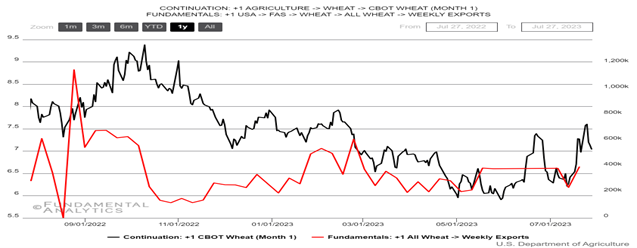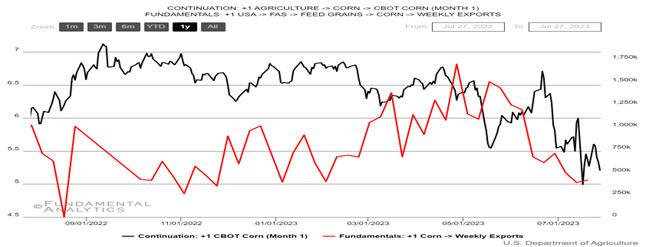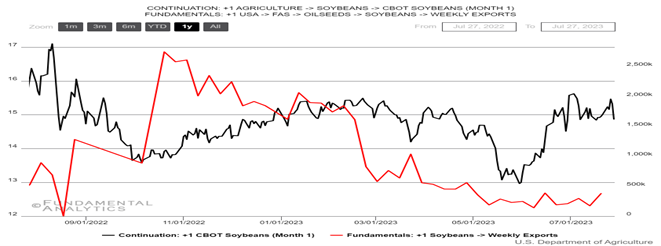August 1, 2023
Decreasing agriculture exports has led to increasingly volatile wheat, corn and soybean futures prices.
Wheat
Weekly Wheat Exports Hit 4-month High – Wheat Futures Retreated from Latest Bullish Sessions
- Weekly wheat exports reported a 4-month peak, standing at 395,132 MT and pushing wheat futures upwards for the week of July 20th.
- Despite the bullish sentiment, wheat prices retreated towards $7 per bushel amid expectations of stronger supply in the U.S., falling sharply from the 5-month high of $7.60 per bushel on July 25th.
- Forecasts of rain in the northern regions of the Midwest and North Dakota eased recent concerns that a blistering heatwave would damage domestic crops.
- Supply expectations remained muted elsewhere after Russia shelled infrastructure and grain warehouses in Odesa and Danube River facilities, limiting the possibility that Ukraine could use European nations to sell grain to foreign markets.
Corn
Corn Exports Remain at Historical Low Level – Corn Futures Display Increased Volatility
- After falling for 3 consecutive weeks, corn exports reported a slight increase, +275,88 MT, standing at 411,418 MT, the lowest point since 2013.
- From mid-June when weekly exports declined sharply, corn futures have plummeted more than -22.35%, despite some short-term bullish sessions.
- Compounding threats to supply and robust demand are considered the main drivers of this dive.
- Renewed dryness in key growing regions of the US raised concerns of lower yields in the incoming harvest, reversing the USDA’s upward revisions to their forecast in their latest report.
Soybeans
Soybeans Exports Are Below 2022 Levels from Late March – Soybean Futures Currently on Breakout
- Soybean futures fell below $15.0/bushel, closing at $14.87/bushel on Friday’s trading session, from a YTD high of $15.62/bushel as a result of short-term relief from hot weather concerns in the U.S. Midwest.
- Soybean futures expect to provide positive returns for the third consecutive week fueled by concerns over crop yields in the United States and improvement in Chinese (who is the biggest importer, 60% of total imports globally) demand prospects.
- The USDA has already revised its forecast for soybean yields in the country, but there are indications that the actual yields could be even lower than currently projected.